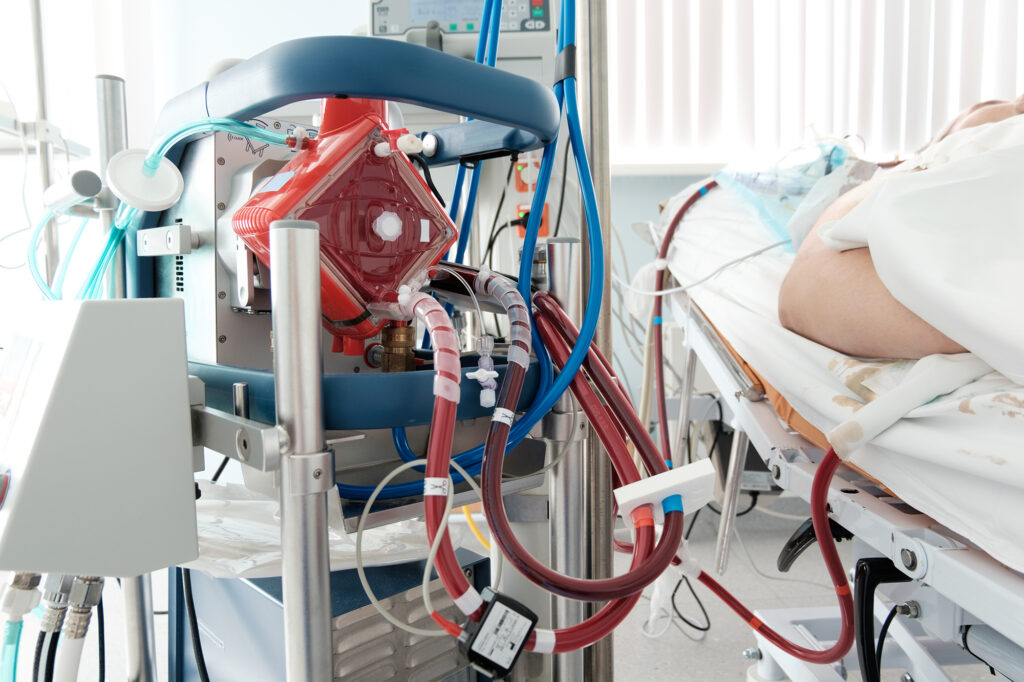
Prone Positioning and ECMO
When patients require mechanical ventilation, occasionally they need multiple interventions to improve their oxygenation. One such intervention that has steadily increased in recent years is the use of Extracorporeal Membrane Oxygenation (ECMO). According to the Extracorporeal Life Support Organization (ELSO) International Report 2016, utilization of extracorporeal life support for the indication of respiratory failure has the greatest increase of utilization as compared to other indications. 1 ECMO is also listed in international guidelines for the management of patients with acute respiratory distress syndrome (ARDS), for severe ARDS (P/F <80).2 It is important to note that this guideline especially states to consider ECMO after utilization of less invasive ARDS interventions such as prone positioning, neuromuscular blocking agents, and high PEEP. 2 In 2021, a retrospective study was performed on patients that were treated with veno-venous ECMO (V-V ECMO) and diagnosed with ARDS. The analysis compared hospital mortality of patients that were treated in the prone or the supine position on V-V ECMO in 6 Italian ECMO centers. 3 There were 107 patients analyzed in the prone/ECMO group and 133 patients in the supine/ECMO group. Mortality at hospital discharge for the prone/ECMO group was 36%, and mortality in the supine/ECMO group was 61%. The incidence of complications in the prone group was small at 6%, with the largest number of these reversible complications being desaturation, with 8% incidence. The study concluded that prone positioning “during ECMO improved oxygenation and was associated with a reduction of hospital mortality”. 3 Prone positioning remains an essential first-line intervention for patients with respiratory compromise, but recent evidence and guidelines suggest that the addition of V-V ECMO for patients that continue to decompensate after prone positioning and other interventions is appropriate. 2,3 The Pronova-O2 Automated Prone Therapy System provides a safe and efficient method for positioning critically ill patients. The critical line management system on Pronova-O2 allows for secure line management for patients that require V-V ECMO, among other invasive treatments. For additional information on automated prone positioning and how Turn Medical can support your ECMO center, please visit turnmedical.com or call 1-855-275-8876. Refer to Pronova-O2 Instructions for Use for full prescribing information including risks.
References
- Thiagarajan, Ravi R.*; Barbaro, Ryan P.†; Rycus, Peter T.‡; Mcmullan, D. Michael; Conrad, Steven A.¶; Fortenberry, James D.‖; Paden, Matthew L.‖; on behalf of the ELSO member centers. Extracorporeal Life Support Organization Registry International Report 2016. ASAIO Journal: January/February 2017 – Volume 63 – Issue 1 – p 60-67 doi: 10.1097/MAT.0000000000000475
- Papazian, L., Aubron, C., Brochard, L., Chiche, J. D., Combes, A., Dreyfuss, D., Forel, J. M., Guérin, C., Jaber, S., Mekontso-Dessap, A., Mercat, A., Richard, J. C., Roux, D., Vieillard-Baron, A., & Faure, H. (2019). Formal guidelines: management of acute respiratory distress syndrome. Annals of intensive care, 9(1), 69. https://doi.org/10.1186/s13613-019-0540-9






